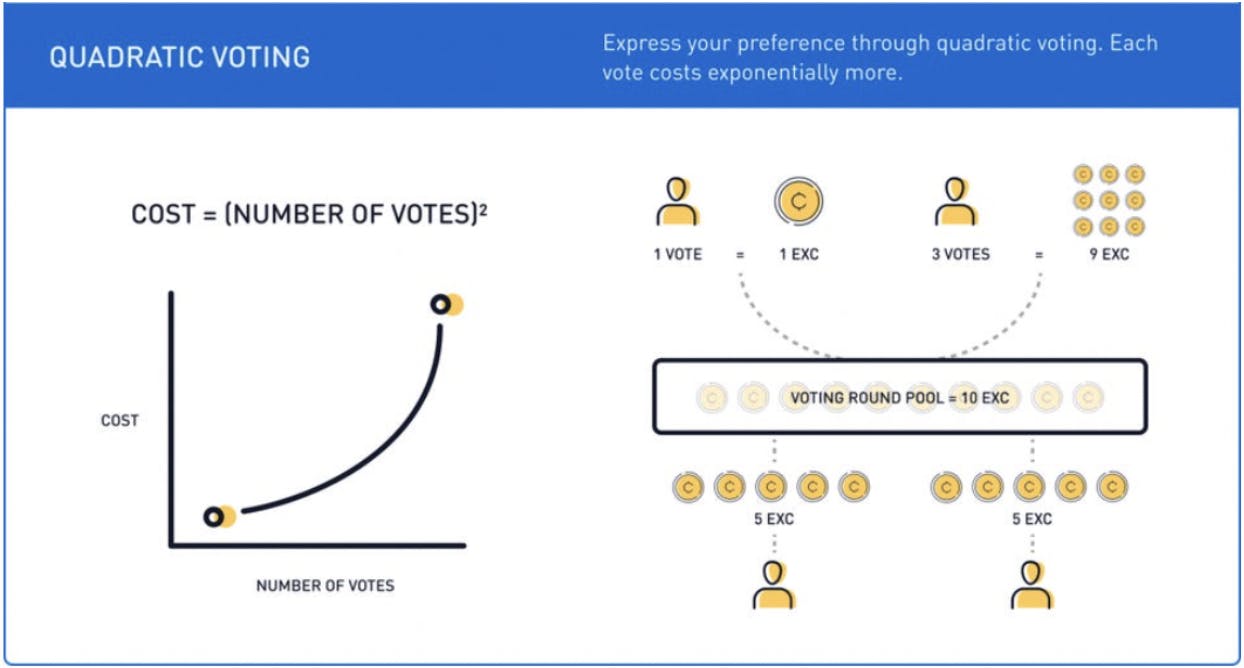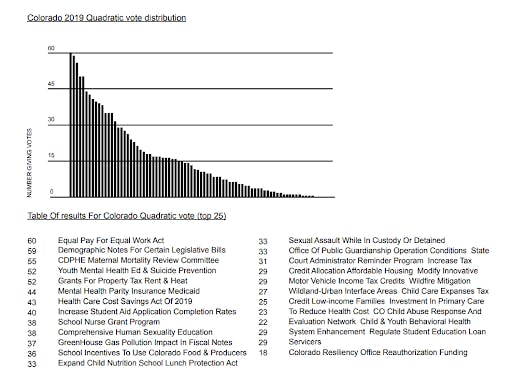Quadratic voting is a method of collective voting which dictates the strength of a voter's feeling, depending on how many votes they allocate to a choice. It differs from the single-choice of voting; instead, you have x amount of votes to give out.
It is a voting system that is notably gaining more traction in the blockchain space and is currently deployed in various democratic institutions and corporate governance.
The Fundamentals of Quadratic Voting
Quadratic voting revolves around each voter having x amount of tokens used to vote, meaning they can vote for multiple options. However, if they want to vote for the same option again, the next vote will cost more tokens than the previous vote.
This voting method follows the quadratic formula, hence the name quadratic voting.
Voters’ cost = (Number of votes)^2
If Bob has 50 tokens and votes for options A, the initial vote will cost one token. If he wants to vote for option A again, the 2nd vote will cost him four tokens, and then the 3rd vote will cost him nine tokens, etc.
This way of voting means that you can vote for multiple options and emphasize your feelings for an option by casting multiple votes at the cost of extra tokens.

In the blockchain space, this reduces plutocracy, as everyone starts with the same amount of voting tokens and hopes that people who care about the issues will cast additional votes to an option to signify their conviction.
Key Points of Quadratic Voting
Currency
If an actual currency is utilized for quadratic voting, this will make the system vulnerable to a pay-to-win model where wealthy individuals could buy more votes. Quadratic voting involves an increased cost for casting multiple votes on the same option. This mechanism would prevent voters with less capital from being able to signify their conviction for an option, thus supporting the wealthy who have more money to deploy.
Now it is expected to use artificial currencies so that everyone starts with an equal amount of voting power, thus an equal say. Using an artificial currency would prevent affluent individuals from taking advantage of their wealth and instead moves the focus of the voting to those who deeply care about the issues.
Sybil attacks
Sybil attacks are the most significant weakness when using a quadratic voting system. A Sybil attack involves individuals with numerous pseudonymous identities to influence community-based decisions. Using an artificial currency is where Sybil attacks are the strongest, as they can vote for free from as many accounts as they wish.
If individuals could create 5, 10, or even 100 accounts, they could easily manipulate the vote in their favor, thus rendering quadratic voting useless. Due to the nature of quadratic voting being open-source and peer-to-peer, there must be anti-Sybil identification software to prevent these attacks from happening.

One way to tackle this issue is to use proof-of-human systems like BrightID or Proof-Of-Humanity. These social identity networks prove that you are only using an account, and your identity is linked to this account. If quadratic voting systems integrate this network, then it will be harder for Sybil attacks to occur since only verified individuals would be able to vote.
Collusion
Collusion is also a potential thresh to quadratic voting. An individual or group could bribe voters to vote for a particular issue, a problem made worse with artificial currencies. Due to the power of signifying your conviction in this system, bribery could easily manipulate the system.
One way to avoid this is to keep all voters anonymous during the voting period. Voters can’t be targeted if malicious actors are unaware of who has voted or not, nor can they confirm if someone they have bribed has voted in their favor until the voting period ends.
Preventing bribery will be a continuous task, and bribery strategies will only get more complex as time goes on, but we must tackle these issues. Otherwise, bribers will outweigh the majority and vote for the option that favors their interests.
Quadratic Voting in Practice
Colorado
The Democrats used quadratic voting in 2019 to decide on their priorities for the next two years, with 109 possible options. They used an artificial currency, with each member given 15 tokens to select an option. Soon they realized 15 tokens was too little, and after reviewing their options with economist Glen Weyl, they increased it to 100 tokens.
Using the quadratic formula above, one individual could give up to 10 votes to one bill. After the vote concluded, the Equal Pay for Equal Work Act won with a total of 60 votes.
This proved to be a massive success for quadratic voting, as there was a clear link between the most discussed topics compared to the bills that garnered the most votes.

Germany
Germany shares another familiar story with the Democrats in Colorado; as Volt Germany, a pan-European party, used quadratic voting to determine the most valued topics in their party manifesto.
Instead, they opted for a ‘burner wallet’, only used for this vote. With their pre-funded wallet, individuals voted for their preferred options, which would signify the most popular topics within the party. Thus creating an anonymous priority list of topics that was immune to social pressure.
Researchers analyzed the voting patterns of this vote and noticed that the topic of Education had garnered a lot of support both from low-and-high conviction votes. In contrast, other issues like the Renewed Economy showed a more skewed vote, with less interest, as most voters did not show their support for it. This type of analysis helps rank the issues of importance for a community and lets them realign their values if necessary.
Summary
Quadratic voting is a system that is rarely used as it is still new but has shown a new path to governance in both the traditional world and the blockchain space. It still has a lot of problems to overcome, but it will be a great way to tackle some of the issues that other voting solutions, such as coin-voting, have as it reduces the plutocracy, the chance of bribery, etc.
I look forward to seeing how DAOs might implement quadratic voting into their governance systems in the future and seeing the different use-cases that will arise, such as the priority rank-list used in the examples. Check out this website here to try quadratic voting for yourself.